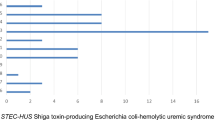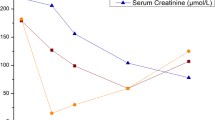Abstract
Background
Shigatoxin-associated hemolytic uremic syndrome (STEC-HUS) is a common thrombotic microangiopathy (TMA) in which central nervous system (CNS) involvement is responsible for the majority of deaths and for severe long-term sequelae. We have analyzed the role of hemoconcentration in disease severity.
Methods
This was a retrospective review of the records and laboratory data at presentation of all patients with STEC-HUS cases (n = 61) over a 10-year period. The patients were grouped into three severity classes: group A, comprising patients who did not require dialysis; group B, patients who were dialyzed without CNS involvement; group C, patients with CNS involvement.
Results
Patients with CNS involvement (group C) had a higher mean hemoglobin level (11.2 ± 2.3 g/dL) than those of group A or B ( 9.4 ± 2.1 and 7.5 ± 1.9 g/dL, respectively; p < 0.0001). We also observed that the higher the initial hemoglobin level, the more severe the long-term renal damage (p < 0.007).
Conclusions
In patients with STEC-HUS, hemoconcentration and hypovolemia may be responsible for more severe ischemic organ damage (both short and long term) at disease onset, and these signs should be regarded as risk factors for CNS damage and for more severe TMA. Therefore, we recommend that hydration status should be actively monitored in HUS patients and that dehydration, when diagnosed, should be promptly corrected.


Similar content being viewed by others
References
Flynn JT (1998) Causes, management approaches, and outcome of acute renal failure in children. Curr Opin Pediatr 10(2):184–189
Ruggenenti P, Noris M, Remuzzi G (2001) Thrombotic microangiopathy, haemolytic uremic syndrome and thrombotic thrombocytopenic purpura. Kidney Int 60:831–846
Gianviti A, Rosmini F, Caprioli A, Corona R, Matteucci MC, Principato F, Luzzi I, Rizzoni G (1994) Haemolytic uraemic syndrome in childhood: surveillance and case-control studies in Italy. Italia HUS Study Group. Pediatr Nephrol 8:705–709
Kaplan BS, Meyers KE, Shulman SI (1998) The pathogenesis and treatment of haemolytic uremic syndrome. J Am Soc Nephrol 9:1126–1133
Schieppati A, Ruggenenti P, Cornejo RP, Errario F, Gregorini G, Zucchelli P, Rossi E, Remuzzi G (1992) Renal function at hospital admission as a prognostic factor in adult haemolytic uremic syndrome. The Italian Registry for Haemolytic Uremic Syndrome. J Am Soc Nephrol 2:1640–1644
Taylor CM, Chua C, Howie AJ, Ridson RA (2004) Clinic-pathological findings in diarrhoea-negative haemolytic uremic syndrome. Pediatr Nephrol 19:419–425
Wong CS, Mooney JC, Brandt JR, Staples AO, Jelacic S, Boster DR, Watkins SL, Tarr PI (2012) Risk factors for the hemolytic uremic syndrome in children infected with Escherichia coli O157:H7: a multivariable analysis. Clin Infect Dis 55(1):33–41
Scheiring J, Andreoli SP, Zimmerhackl LB (2008) Treatment and outcome of Shiga-toxin-associated hemolytic uremic syndrome (HUS). Pediatr Nephrol 23:1749–1760
Noris M, Remuzzi G (2005) Hemolytic uremic syndrome. J Am Soc Nephrol 6:1035–1050
Eriksson K, Boyd S, Tasker R (2001) Acute neurology and neurophysiology of haemolytic uraemic syndrome. Arch Dis Child 84:434–435
Oakes R, Siegler R, Mc Reynolds M, Pysher T, Pavia A (2006) Predictors of fatality in postdiarreheal haemolytic uremic syndrome. Pediatrics 117:1656–166
Ojeda JM, Kohout I, Cuestas E (2013) Dehydration upon admission is a risk factor for incomplete recovery of renal function in children with haemolytic uremic syndrome. Nefrologia 33:372–376
Rooney JC, Anderson RM, Hopkins IJ (1971) Clinical and pathological aspects of central nervous system involvement in the hemolytic-uremic syndrome. Aust Paediatr J 7:28–33
Gianantonio CA, Vitacco M, Mendilaharzu F, Gallo GE, Sojo ET (1973) The hemolytic-uremic syndrome. Nephrol 11:172–192
Bale JF, Brasher C, Sigler RL (1980) CNS manifestations of the hemolytic-uremic syndrome: relationship to metabolic alterations and prognosis. Am J Dis Child 134:869–872
Upadhyaya K, Barwick K, Fishaut M, Kashgarian M, Siegel NJ (1980) The importance of nonrenal involvement in haemolytic uremic syndrome. Pediatrics 65:115–120
Nathanson S, Kwon T, Elmaleh M, Charbit M, Launay EA, Harambat J, Brun M, Ranchin B, Bandin F, Cloarec S, Bourdat-Michel G, Piètrement C, Champion G, Ulinski T, Deschênes G (2010) Acute neurological involvement in diarrhea-associated hemolytic uremic syndrome. Clin J Am Soc Nephrol 5:1218–1228
Sheth K, Herbert S, Haworth N (1986) Neurogical involvement in hemolytic uremic syndrome. Ann Neurol 19:90–93
Dhuna A, Pascual LA, Talwar D, Torres F (1992) EEG and seizures in children with haemolytic uremic syndrome. Epilepsia 33(3):482–486
Jeong YK, Kim IO, Kin WS, Hwamg YS, Choi Y, Yeon KM (1994) Haemolytic uremic syndrome: MR findings of CNS complications. Pediatr Radiol 24:584–586
Theobald I, Kuwertz-Broking E, Schiborr M, Heindel W (2001) Central nervous system involvement in haemolytic uremic syndrome (HUS)—a retrospective analysis of cerebral CT and MRI studies. Clin Nephrol 56(1):S3–S8
Hager A, Staudt M, von Klare B, Einsiedel Grafin H, Krageloh-Mann I (1999) Hemolytic-uremic syndrome with involvement of basal ganglia and cerebellum. Neuropediatrics 30:210–213
Ake J, Jelacic S, Ciol M, Watkins S, Murray K, Christie D, Klein E, Tarr P (2005) Relative nephroprotection during Escherichia Coli 0157:H7 infections: association with intravenous volume expansion. Pediatrics 115:673–680
Hickey CA, Beattie TJ, Cowieson J, Miyashita Y, Strife CF, Frem JC, Peterson JM, Butani L, Jones DP, Havens PL, Patel HP, Wong CS, Andreoli SP, Rothbaum RJ, Beck AM, Tarr PI (2011) Early volume expansion during diarrhea and relative nephroprotection during subsequent hemolytic uremic syndrome. Arch Pediatr Adolesc Med 165:884–889
Balestracci A, Martin SM, Toledo I, Alvarado C, Wainsztein RE (2012) Dehydration at admission increased the need for dialysis in hemolytic uremic syndrome children. Pediatr Nephrol 27(8):1407–1410
Kidney Disease: Improving Global Outcomes (KDIGO) CKD Work Group (2013) KDIGO 2012 Clinical Practice Guideline for the evaluation and management of chronic kidney disease. Kidney Int Suppl 3:1–150
Schwartz GJ, Brion LP, Spitzer A (1987) The use of plasma creatinine concentration for estimating glomerular filtration rate in infants, children, and adolescents. Pediatr Clin North Am 34:571–590
Gianviti A, Tozzi AE, De Petris L, Caprioli A, Ravà L, Edefonti A, Ardissino G, Montini G, Zacchello G, Ferretti A, Pecoraro C, De Palo T, Caringella A, Gaido M, Coppo R, Perfumo F, Miglietti N, Ratsche I, Penza R, Capasso G, Maringhini S, Li Volti S, Setzu C, Pennesi M, Bettinelli A, Peratoner L, Pela I, Salvaggio E, Lama G, Maffei S, Rizzoni G (2003) Risk factors for poor renal prognosis in children with haemolytic uremic syndrome. Pediatr Nephrol 18:1229–1235
Kelles A, Van Dyck M, Proesmans W (1994) Childhood haemolytic uraemic syndrome: long term outcome and prognostic features. Eur J Pediatr 153:38–42
Siegler RL, Pavia AT, Christofferson RD, Milligan MK (1994) A 20-year population based study of post diarrhoeal haemolytic uremic syndrome in Utah. Pediatrics 94:35–40
Gallo GE, Gianantonio CA (1995) Extrarenal involvement in post-diarrhoea-associated haemolytic uraemia syndrome. Pediatr Nephrol 9:117–119
Stricklett PK, Hughes AK, Ergonul Z, Kohan DE (2002) Molecular basis for up-regulation by inflammatory cytokines of Shiga toxin 1 cytotoxicity and globotriaosylceramide expression. J Infect Dis 186(7):976–982
Holtz LR, Neill MA, Tarr PI (2009) Acute bloody diarrhea: a medical emergency for patients of all ages. Gastroenterology 136:1887–1898
Coad NA, Marshall T, Rowe B, Taylor CM (1991) Changes in the postenteropathic form of the hemolytic uremic syndrome in children. Clin Nephrol 35(1):10–16
Acknowledgments
Gianluigi Ardissino, Center for HUS Control, Prevention and Management, Fondazione IRCCS Ca’ Granda Ospedale Maggiore Policlinico, Milan, Italy, had full access to all the data in the study and takes responsibility for the integrity of the data and the accuracy of the data analysis.
Funding source
All aspects of this study were funded by a research grant from the "Progetto Alice ONLUS. Associazione per la lotta alla SEU"
Financial disclosure
None.
Conflict of interest
None.
Author information
Authors and Affiliations
Corresponding author
Rights and permissions
About this article
Cite this article
Ardissino, G., Daccò, V., Testa, S. et al. Hemoconcentration: a major risk factor for neurological involvement in hemolytic uremic syndrome. Pediatr Nephrol 30, 345–352 (2015). https://doi.org/10.1007/s00467-014-2918-0
Received:
Revised:
Accepted:
Published:
Issue Date:
DOI: https://doi.org/10.1007/s00467-014-2918-0




